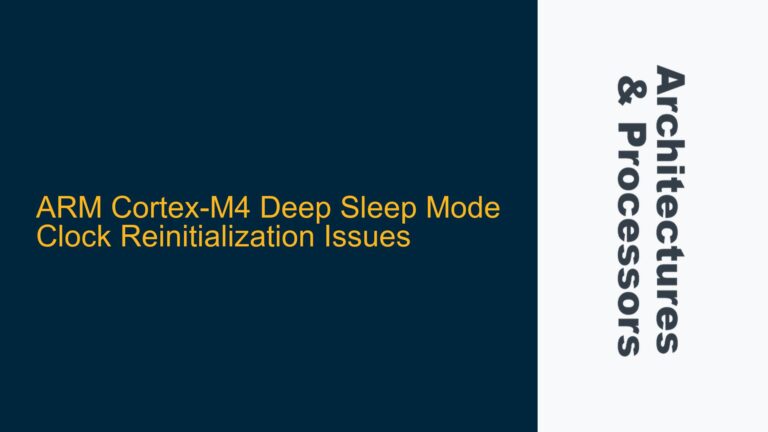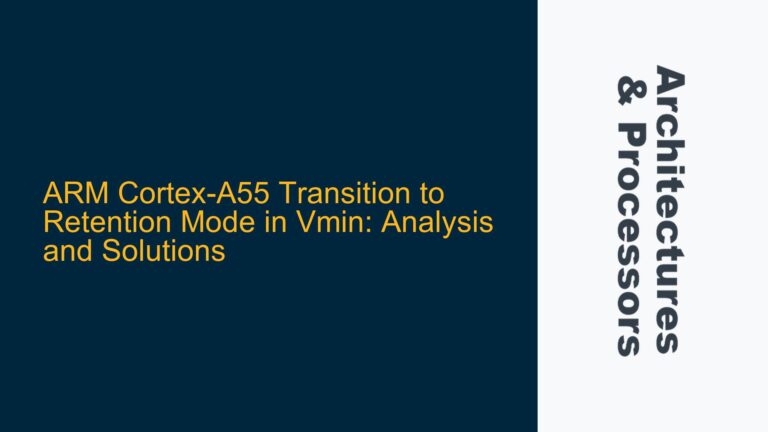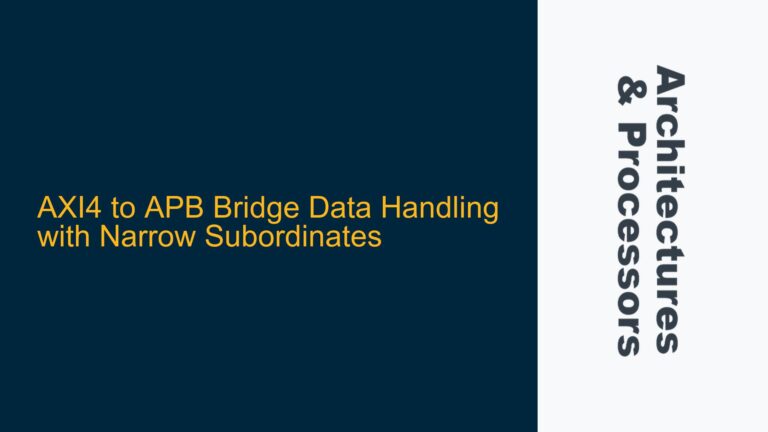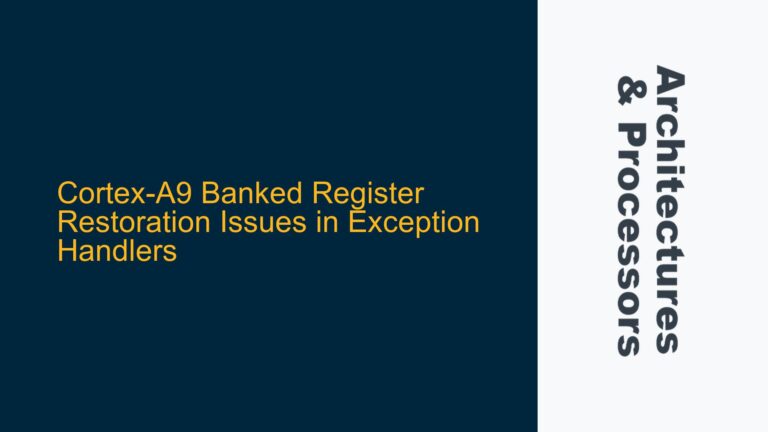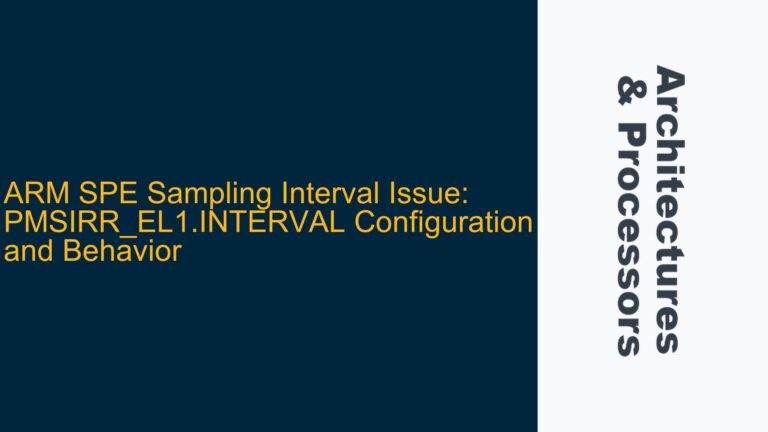Configuring Non-Cacheable Memory Regions via MMU for Direct RAM Writes
The ARM Cortex-A53 processor, like many modern processors, employs a memory hierarchy that includes caches and store buffers to optimize performance. However, certain applications, such as real-time systems or specific research scenarios, may require data to be written directly to RAM, bypassing these optimizations. To achieve this, the Memory Management Unit (MMU) must be configured to mark specific memory regions as non-cacheable.
The MMU is responsible for translating virtual addresses to physical addresses and for managing memory attributes, including cacheability. By setting up the MMU to mark a memory region as non-cacheable, any store operations to that region will bypass the cache and write directly to RAM. This is particularly useful when the data being written needs to be immediately visible to other system components, such as DMA controllers or other processors in a multi-core system.
To configure a memory region as non-cacheable, the page table entries (PTEs) for that region must be modified. The PTEs contain bits that control the cacheability of the memory region. Specifically, the "C" (Cacheable) and "B" (Bufferable) bits in the PTE must be cleared to disable caching and buffering for that region. The exact procedure for modifying the PTEs depends on the operating system and the specific MMU implementation, but generally involves the following steps:
-
Identify the Memory Region: Determine the virtual address range that needs to be marked as non-cacheable. This could be a specific range of addresses allocated for a particular purpose, such as a shared memory region or a DMA buffer.
-
Modify the Page Table Entries: Locate the PTEs corresponding to the identified memory region and clear the "C" and "B" bits. This can be done by directly manipulating the page tables if the operating system allows it, or by using system calls or APIs provided by the operating system to modify the memory attributes.
-
Invalidate the TLB: After modifying the PTEs, the Translation Lookaside Buffer (TLB) must be invalidated to ensure that the changes take effect immediately. The TLB is a cache of recently used page table entries, and invalidating it forces the MMU to reload the updated PTEs from memory.
-
Verify the Configuration: Once the memory region has been marked as non-cacheable, verify that store operations to that region bypass the cache and write directly to RAM. This can be done by performing a series of store operations and observing the behavior using a debugger or memory analyzer.
By following these steps, you can ensure that data is written directly to RAM, bypassing the cache and store buffer. This is particularly important in scenarios where the immediacy of data visibility is critical, such as in real-time systems or when interfacing with hardware that expects data to be immediately available in RAM.
Store Buffer Behavior and the Role of DSB and DMB Instructions
The store buffer in the ARM Cortex-A53 processor is a hardware structure that temporarily holds store operations before they are committed to memory. The store buffer allows the processor to continue executing instructions without waiting for store operations to complete, which improves performance. However, this behavior can lead to situations where the order of store operations is not preserved, or where store operations are delayed, which may not be desirable in certain scenarios.
When two consecutive store operations are performed to the same address, the store buffer may "block" the second store until the first store has been committed to memory. This can lead to situations where the second store is delayed, which may not be acceptable in real-time systems or when precise timing is required.
To control the behavior of the store buffer and ensure that store operations are committed to memory in a timely manner, the ARM architecture provides two instructions: Data Memory Barrier (DMB) and Data Synchronization Barrier (DSB).
-
Data Memory Barrier (DMB): The DMB instruction ensures that all memory accesses before the barrier are completed before any memory accesses after the barrier are started. This guarantees the order of memory operations but does not necessarily force the store buffer to commit its contents to memory. In the context of the store buffer, a DMB instruction between two store operations ensures that the first store is completed before the second store begins, but it does not guarantee that the first store has been committed to memory.
-
Data Synchronization Barrier (DSB): The DSB instruction is a stronger form of barrier that ensures all memory accesses before the barrier are completed before any instructions after the barrier are executed. This includes waiting for the store buffer to be drained, ensuring that all store operations have been committed to memory. In the context of the store buffer, a DSB instruction between two store operations ensures that the first store is committed to memory before the second store begins.
In the scenario where two consecutive store operations are performed to the same address, a DSB instruction should be used to ensure that the first store is committed to memory before the second store begins. This guarantees that the second store will overwrite the first store in memory, rather than being delayed by the store buffer.
For example, consider the following sequence of store operations:
STR R0, [R1] ; Store the value in R0 to the address in R1
DSB ; Data Synchronization Barrier
STR R2, [R1] ; Store the value in R2 to the address in R1
In this sequence, the DSB instruction ensures that the first store operation (STR R0, [R1]) is committed to memory before the second store operation (STR R2, [R1]) begins. This guarantees that the second store will overwrite the first store in memory, rather than being delayed by the store buffer.
Implementing Data Synchronization Barriers and Cache Management for Reliable Direct RAM Writes
To ensure reliable direct RAM writes in the ARM Cortex-A53 processor, it is essential to implement proper data synchronization barriers and cache management techniques. These techniques ensure that store operations are committed to memory in a timely manner and that the cache does not interfere with the visibility of the data.
Data Synchronization Barriers (DSB)
As discussed earlier, the DSB instruction is used to ensure that all memory accesses before the barrier are completed before any instructions after the barrier are executed. This includes waiting for the store buffer to be drained, ensuring that all store operations have been committed to memory.
In the context of direct RAM writes, the DSB instruction should be used after each store operation to ensure that the data is immediately visible in RAM. This is particularly important in scenarios where the data needs to be immediately available to other system components, such as DMA controllers or other processors in a multi-core system.
For example, consider the following sequence of store operations:
STR R0, [R1] ; Store the value in R0 to the address in R1
DSB ; Data Synchronization Barrier
STR R2, [R1] ; Store the value in R2 to the address in R1
DSB ; Data Synchronization Barrier
In this sequence, the DSB instruction is used after each store operation to ensure that the data is immediately committed to memory. This guarantees that the data is immediately visible in RAM and that subsequent store operations will not be delayed by the store buffer.
Cache Management
In addition to using data synchronization barriers, proper cache management is essential to ensure that store operations bypass the cache and write directly to RAM. As discussed earlier, this can be achieved by configuring the MMU to mark specific memory regions as non-cacheable.
However, in some cases, it may be necessary to manage the cache manually to ensure that store operations bypass the cache. This can be done using cache maintenance operations, such as cache invalidations and clean operations.
-
Cache Invalidation: Cache invalidation is used to remove data from the cache, ensuring that subsequent memory accesses will fetch the data from RAM. In the context of direct RAM writes, cache invalidation can be used to ensure that the cache does not hold stale data that could interfere with the visibility of the data in RAM.
-
Cache Clean: Cache clean operations are used to write dirty data from the cache back to RAM. In the context of direct RAM writes, cache clean operations can be used to ensure that any data in the cache that has been modified is written back to RAM before the cache is invalidated.
For example, consider the following sequence of cache maintenance operations:
DC CIVAC, R1 ; Invalidate the cache line for the address in R1
DSB ; Data Synchronization Barrier
STR R0, [R1] ; Store the value in R0 to the address in R1
DSB ; Data Synchronization Barrier
DC CIVAC, R1 ; Invalidate the cache line for the address in R1
DSB ; Data Synchronization Barrier
In this sequence, the cache line for the address in R1 is invalidated before the store operation to ensure that the cache does not hold stale data. After the store operation, the cache line is invalidated again to ensure that the data is immediately visible in RAM.
Combining DSB and Cache Management
To achieve reliable direct RAM writes, it is often necessary to combine data synchronization barriers with cache management techniques. This ensures that store operations are committed to memory in a timely manner and that the cache does not interfere with the visibility of the data.
For example, consider the following sequence of instructions:
DC CIVAC, R1 ; Invalidate the cache line for the address in R1
DSB ; Data Synchronization Barrier
STR R0, [R1] ; Store the value in R0 to the address in R1
DSB ; Data Synchronization Barrier
DC CIVAC, R1 ; Invalidate the cache line for the address in R1
DSB ; Data Synchronization Barrier
In this sequence, the cache line for the address in R1 is invalidated before the store operation to ensure that the cache does not hold stale data. After the store operation, the cache line is invalidated again to ensure that the data is immediately visible in RAM. The DSB instructions are used to ensure that the store operation is committed to memory before the cache is invalidated.
By combining data synchronization barriers with cache management techniques, you can ensure that store operations bypass the cache and write directly to RAM, providing reliable and immediate visibility of the data in memory.
Conclusion
In summary, achieving direct RAM writes in the ARM Cortex-A53 processor requires careful configuration of the MMU to mark specific memory regions as non-cacheable, proper use of data synchronization barriers to ensure that store operations are committed to memory in a timely manner, and effective cache management to prevent the cache from interfering with the visibility of the data. By following these techniques, you can ensure that your software performs reliable and immediate writes to RAM, bypassing the cache and store buffer as needed.


